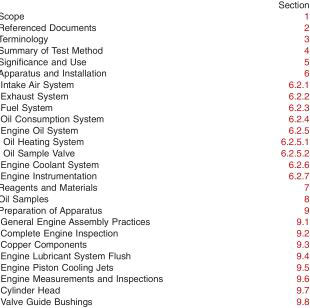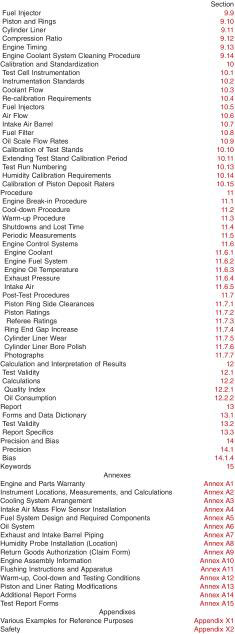1. Scope
1.1 This test method covers and is required to evaluate the performance of engine oils intended to satisfy certain American Petroleum Institute (API) C service categories (included in Specification D4485). It is performed in a laboratory using a standardized high-speed, single-cylinder diesel engine. Piston and ring groove deposit-forming tendency and oil consumption is measured. The piston, the rings, and the liner are also examined for distress and the rings for mobility.
1.2 The values stated in SI units are to be regarded as standard. No other units of measurement are included in this standard.
1.2.1 Exceptions - Where there is no direct SI equivalent such as screw threads, National Pipe Threads/diameters, tubing size, or where there is a sole source supply equipment specification.
1.3 This standard does not purport to address all of the safety concerns, if any, associated with its use. It is the responsibility of the user of this standard to establish appropriate safety and health practices and determine the applicability of regulatory limitations prior to use. Being an engine test method, this standard does have definite hazards that require safe practices (see Appendix X2 on Safety).
1.4 The following is the Table of Contents:


2. Referenced Documents
2.1 ASTM Standards:
D86 Test Method for Distillation of Petroleum Products at Atmospheric Pressure
D93 Test Methods for Flash Point by Pensky-Martens Closed Cup Tester
D97 Test Method for Pour Point of Petroleum Products
D130 Test Method for Corrosiveness to Copper from Petroleum Products by Copper Strip Test
D235 Specification for Mineral Spirits (Petroleum Spirits) (Hydrocarbon Dry Cleaning Solvent)
D445 Test Method for Kinematic Viscosity of Transparent and Opaque Liquids (and Calculation of Dynamic Viscosity)
D482 Test Method for Ash from Petroleum Products
D524 Test Method for Ramsbottom Carbon Residue of Petroleum Products
D613 Test Method for Cetane Number of Diesel Fuel Oil
D664 Test Method for Acid Number of Petroleum Products by Potentiometric Titration
D1319 Test Method for Hydrocarbon Types in Liquid Petroleum Products by Fluorescent Indicator Adsorption
D2274 Test Method for Oxidation Stability of Distillate Fuel Oil (Accelerated Method)
D2425 Test Method for Hydrocarbon Types in Middle Distillates by Mass Spectrometry
D2500 Test Method for Cloud Point of Petroleum Products
D2622 Test Method for Sulfur in Petroleum Products by Wavelength Dispersive X-ray Fluorescence Spectrometry
D2709 Test Method for Water and Sediment in Middle Distillate Fuels by Centrifuge
D3227 Test Method for (Thiol Mercaptan) Sulfur in Gasoline, Kerosine, Aviation Turbine, and Distillate Fuels (Potentiometric Method)
D3524 Test Method for Diesel Fuel Diluent in Used Diesel Engine Oils by Gas Chromatography
D4175 Terminology Relating to Petroleum, Petroleum Products, and Lubricants
D4052 Test Method for Density, Relative Density, and API Gravity of Liquids by Digital Density Meter
D4485 Specification for Performance of Active API Service Category Engine Oils
D4739 Test Method for Base Number Determination by Potentiometric Hydrochloric Acid Titration
D5185 Test Method for Multielement Determination of Used and Unused Lubricating Oils and Base Oils by Inductively Coupled Plasma Atomic Emission Spectrometry (ICP-AES)
D5862 Test Method for Evaluation of Engine Oils in Two-Stroke Cycle Turbo-Supercharged 6V92TA Diesel Engine (Withdrawn 2009)
D6202 Test Method for Automotive Engine Oils on the Fuel Economy of Passenger Cars and Light-Duty Trucks in the Sequence VIA Spark Ignition Engine (Withdrawn 2009)
D6593 Test Method for Evaluation of Automotive Engine Oils for Inhibition of Deposit Formation in a Spark-Ignition Internal Combustion Engine Fueled with Gasoline and Operated Under Low-Temperature, Light-Duty Conditions
D7422 Test Method for Evaluation of Diesel Engine Oils in T-12 Exhaust Gas Recirculation Diesel Engine
E29 Practice for Using Significant Digits in Test Data to Determine Conformance with Specifications
G40 Terminology Relating to Wear and Erosion
2.2 SAE Standard:
SAE J183 Engine Oil Performance and Engine Service Classification
2.3 API Standard:
API 1509 Engine Service Classification and Guide to Crankcase Oil Selection
2.4 Other ASTM Document:
ASTM Deposit Rating Manual 20 (formerly CRC Manual 20)
3. Terminology
3.1 Definitions:
3.1.1 additive, n - a material added to another, usually in a small amount, to impart or enhance desirable properties or to suppress undesirable properties.
3.1.2 automotive, adj - descriptive of equipment associated with self-propelled machinery, usually vehicles driven by internal combustion engines.
3.1.3 blind reference oil, n - a reference oil, the identity of which is unknown by the test facility.
3.1.3.1 Discussion - This is a coded reference oil which is submitted by a source independent from the test facility.
3.1.4 blowby, n - in internal combustion engines, that portion of the the combustion products and unburned air/fuel mixture that leaks past piston rings into the engine crankcase during operation.
3.1.5 calibrate, v - to determine the indication or output of a device (e.g., thermometer, manometer, engine) with respect to that of a standard.
3.1.6 calibrated test stand, n - a test stand on which the testing of reference material(s), conducted as specified in the standard, provided acceptable test results.
3.1.6.1 Discussion - In several automotive lubricant standard test methods, the ASTM Test Monitoring Center provides testing guidance and determines acceptability.
3.1.7 candidate oil, n - an oil which is intended to have the performance characteristics necessary to satisfy a specification and is to be tested against that specification.
3.1.7.1 Discussion - These oils are mainly submitted for testing as candidates to satisfy a specified performance; hence the designation of the term.
3.1.8 debris, n - in internal combustion engines, solid contaminant materials unintentionally introduced into the engine or resulting from wear.
3.1.9 dispersant, n - in engine oil, an additive that reduces deposits on oil-wetted engine surfaces primarily through suspension of particles.
3.1.10 engine oil, n - a liquid that reduces friction or wear, or both, between the moving parts within an engine; removes heat, particularly from the underside of pistons; and serves as a combustion gas sealant for the piston rings.
3.1.10.1 Discussion - It may contain additives to enhance certain properties. Inhibition of engine rusting, deposit formation, valve train wear, oil oxidation and, foaming are examples.
3.1.11 heavy-duty, adj - in internal combustion engine operation, characterized by average speeds, power output, and internal temperatures that are generally close to the potential maximums.
3.1.12 lubricant, n - any material interposed between two surfaces that reduces the friction or wear, or both, between them.
3.1.13 lubricating oil, n - a liquid lubricant, usually comprising several ingredients, including a major portion of base oil and minor portions of various additives.
3.1.14 oxidation, n - of engine oil, the reaction of the oil with an electron acceptor, generally oxygen, that can produce deleterious acidic or resinous materials often manifested as sludge formation, varnish formation, viscosity increase, or corrosion, or a combination thereof.
3.1.15 non-reference oil, n - any oil other than a reference oil; such as a research formulation, commercial oil, or candidate oil.
3.1.16 purchaser, n - of an ASTM test, person or organization that pays for the conduct of an ASTM test method on a specified product.
3.1.17 reference oil, n - an oil of known performance characteristics, used as a basis for comparison.
3.1.17.1 Discussion - Reference oils are used to calibrate testing facilities, to compare the performance of other oils, or to evaluate other material (such as seals) that interact with oils.
3.1.18 scoring, n - in tribology, a severe form of wear characterized by the formation of extensive grooves and scratches in the direction of sliding.
3.1.19 scuffing, n - in lubrication, damage caused by instantaneous localized welding between surfaces in relative motion which does not result in immobilization of the parts.
3.1.20 sponsor, n - of an ASTM test method, an organization that is responsible for ensuring supply of the apparatus used in the test procedure portion of the test method.
3.1.20.1 Discussion - In some instances, such as a test method for chemical analysis, an ASTM working group can be the sponsor of the test method. In other instances, a company with a self-interest may or may not be the developer of the test procedure used within the method, but is the sponsor of the test method.
3.1.21 used oil, n - any oil that has been in a piece of equipment (for example, an engine, gearbox, transformer, or turbine), whether operated or not.
3.1.22 varnish, n - in internal combustion engines, a hard, dry, generally lustrous deposit that can be removed by solvents but not by wiping with a cloth.
3.1.23 wear, n - the loss of material from a surface, generally occurring between two surfaces in relative motion, and resulting from mechanical or chemical action or a combination of both.



